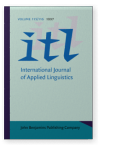Vol. 115/116 (1997) ► pp.111–136
Vol. 115/116 (1997) ► pp.111–136
Personality and Language Learning
The Contradiction between Psychologists and Applied Linguists
There is a clear contradiction between the predictions of psychologists and applied linguists regarding the relationship between extraversion and learning. Psychologists claim that extraversion is a disadvantage for learning on the ground that an extravert has "less cortical arousal", is more easily "inhibited" and has a "limited long term memory". In contrast, many applied linguists predict that extraversion is an advantage for learning a second/foreign language on the assumption that an extravert elicits more "input" and produces more "output". To resolve this conflict, forty Iranian Ph.D. students who sat for TOEFL and IELTS were given the Persian restandardised form of Eysenck Personality Questionnaire (EPQ) twice. They were also asked to report their Grade Point Averages (GPA) of Diploma, Bachelor and Master. A pattern of negative but nonsignificant relationship was found between extraversion and GPAs. An even weaker but still negative relation emerged between extraversion and both total and subscores of TOEFL & IELTS. It might be concluded that extraversion may not help in developing cither linguistic skills (e.g. Structure section of TOEFL) or even communicative skills (e.g. Speaking of IELTS) in an Iranian EFL situation where there is no exposure to English and non-communicative teaching methods are used in English classes. It would be more interesting to see if extraversion helps learning English in ESL situation where exposure is present and the learners have the chance to communicate in English both inside and outside the class environment. It may also be more revealing to measure English proficiency by administering various tests with different nature.
